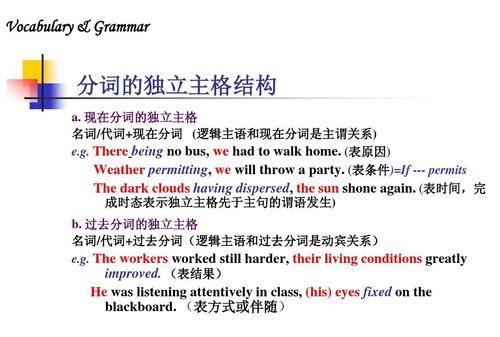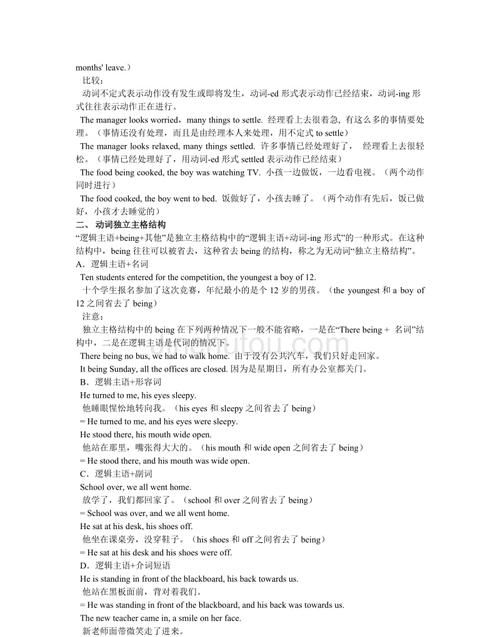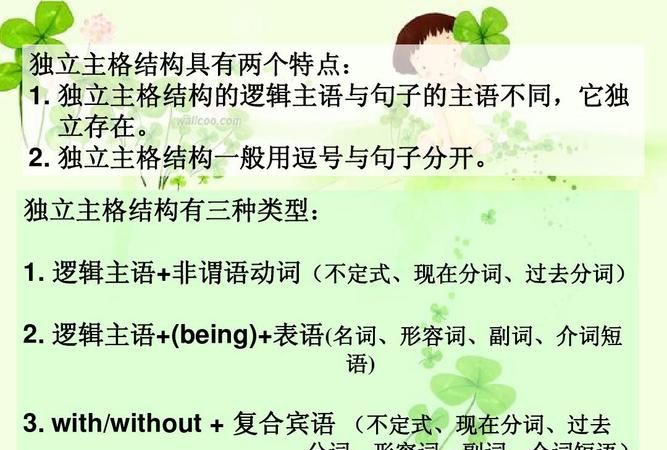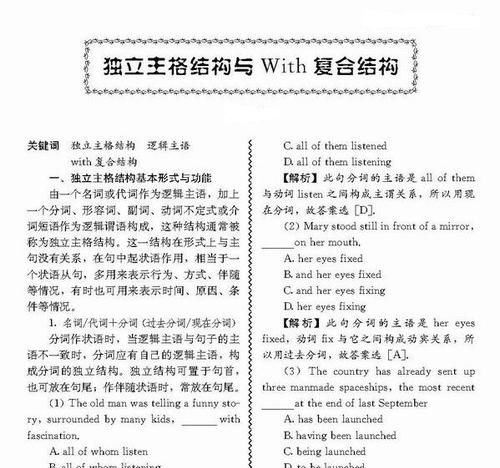本文目录
独立主格结构和非谓语动词的区别
独立主格结构(Independent Genitive)有两部分组成,前一部份是名词或者代词,后一部分是非谓语动词(不定式、动名词和分词)或形容词、副词、或介词短语。前后两部分具有逻辑主谓关系。独立主格结构在句中做状语,多用于书面语。 独立主格结构本身不是句子,在句子中作状语,表示时间、原因、条件、伴随、目的等。
非谓语动词是指在句子中不是谓语的动词,主要包括不定式、动名词和分词(现在分词和过去分词),即动词的非谓语形式。非谓语动词除了不能独立作谓语外,可以承担句子的任何成分。
这个是基本概念,另外非谓语中的主语和主句中的主语是一致的,但是独立主格却和主句主语不一样,因此是独立的主格。

非谓语动词和独立主格的区别
独立主格结构不是主谓完整的简单句,而只是一个短语。
其公式为:名词/名词短语/代词+不定式/ing分词/ed分词/形容词/副词/介词短语。名词前也可以加with。
非谓语动词是指在句子中不是谓语的动词,主要包括不定式、动名词和分词(现在分词和过去分词),即动词的非谓语形式。非谓语动词除了不能独立作谓语外,可以承担句子的其他成分。
***/link?url=lHBYdIeSZkt_61nvu3_jAwPcGhNpSENF8HK7VLIauHFKeP6RjIV6ft2oCrzDV5ky3ftKXMKYLWr5odGxBABvR_v67gFXRSn7DxknvrJI9SNbe89aN0AOE-3XjKIX_KOw
***/link?url=yW1z2flN5kM9fho3s1U-A3ZZgu-UQrJsDzQgoWqFFd02SEZ3xc6gx0WZcKEzrsOAo-Nxi1cAo0csfKU2Q9EKM3ZxbHcWMJKFlmvgTmlZ8TktcFeeXo-mNORy3t80qrhtiJwACENlPgXDB0RT1YEA9K

什么是独立主格结构
百度百科上说的挺细的,不知道你看没,但是不够概括。
好像现在还没有准确的定义,简单的说独立主格结构就是一句话里除了主句还有单独的主谓关系,但是是不完整的。
独立主格结构是传统的叫法,英语是Nominative Absolute Construction,又叫独立分词结构 (Nominative Absolute Participial Construction)。分为非限定分句和无动词分句。像分词、不定式、ed形式的属于非限定分句;而名词词组+形容词/副词/介词短语等,没有任何形式的动词词组,属于无动词分句。

英语中什么叫独立结构
独立主格
一、 独立主格结构的含义和实质
“独立主格结构”(absolute construction)又叫“独立结构”,是带有自己主语的非谓语动词分句和无动词分句。由于在语法上有自己的逻辑主语,结构上与主句不发生关系,因此传统语法叫做“独立主格结构”。其实,所谓“独立主格结构”并非真正独立,它还是一种从属分句,与主句紧密联系在一起,共同表达一个完整的意思,通常在句中起状语分句的作用。独立主格结构可放于句首、句尾,用逗号和主句隔开。
二、 独立主格结构的基本形式和功能
独立主格结构可以分为两部分:一部分是名词或代词,起逻辑主语的作用;另一部分是非谓语动词分句(现在分词、过去分词、不定式)或无动词分句(名词、形容词、副词、介词短语),表示前面名词或代词的动作或状态。
基本形式是:名词普通格/代词主格+现在分词/过去分词/不定式/名词/形容词/副词/介词短语,with引导的复合结构。
1. 名词/代词+ 现在分词
现在分词表示前面的名词或代词主动进行的动作或状态等。
例 The man lay there, his hands trembling.
So many students being absent, the meeting had to be put off.
His homework having been done, Tom went to sleep.
注:“独立结构”中的being或 having been 有时可以省去,这样就成了无动词分句或过去分词分句。
2. 名词/代词+过去分词
过去分词表示前面的名词或代词被动完成的动作或所处的一种状态。
例 The boy lay on his back, his hands crossed under his head.
The job not finished, we couldn’t see the film.
Her shirt caught on a nail, she could not move.
后面两个句子也可以看成省略掉了having been,being。如果加上,这两个句子就又变成了现在分词分句。
3. 名词/代词+不定式
不定式表示的是将来的动作。
例He suggested going for a picnic, Mary to provide the food.
These are the first two books, the third one to come out next month.
We shall get together at 7:30, the procession(游行) to start moving at 8 sharp.
4. 名词/代词+名词
名词一般做前面名词或代词的同位语。
例 Many people joined in the work, some of them women and children.
He fought the tiger,a stick his only weapon.
5. 名词/代词+形容词短语
形容词(短语)说明前面名词或代词的性质,状态,原因等。
例The floor wet and slippery, we had to stay outside for a while.
I heard that she got injured in the accident, my heart full of sorry.
这两个句子也可以看成是省略了being,如果加上,就变成了现在分词分句。
6. 名词/代词+副词
副词说明前面名词或代词的状态。
例 The meeting over, we all went home.
Nobody in, he left a message on the board.
He sat at the table, head down.
7. 名词/代词+介词短语
介词短语说明伴随前面名词或代词的方式或者状态。
例 The teacher came in, a book under his arm.
The hunter entered the forest, gun in hand.
Nobody at home, the thief took a lot of things away.
8. with引导的复合结构, 也可以认为是一种独立主格结构
例 A woman got on the bus with a baby around her arms.
The teacher came in with several students following behind.
With a lot of things to deal with, he will have a difficult time.
With the work done, he went out to eat.
He left the office with the lights on.
Mary rushed out of the house with the door open.

以上就是关于独立主格和无动词分句的区别,独立主格结构和非谓语动词的区别的全部内容,以及独立主格和无动词分句的区别 的相关内容,希望能够帮到您。

